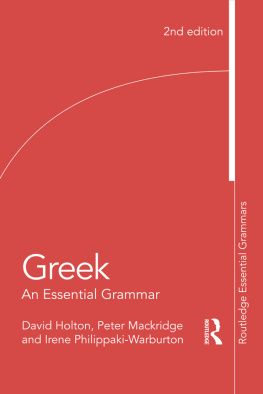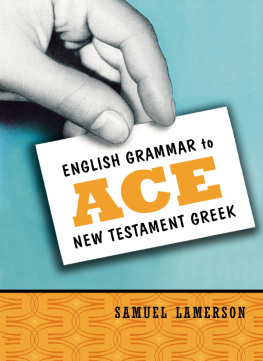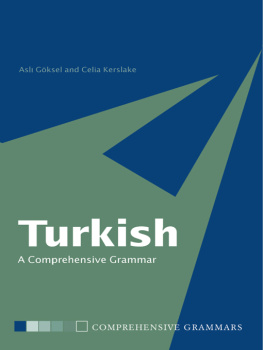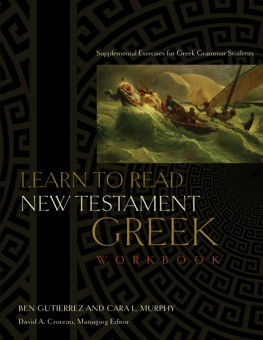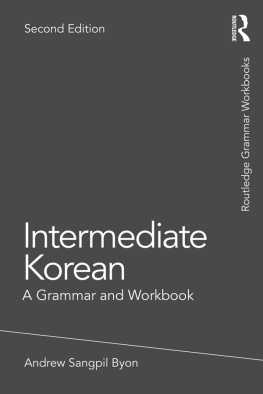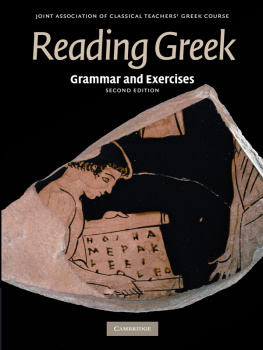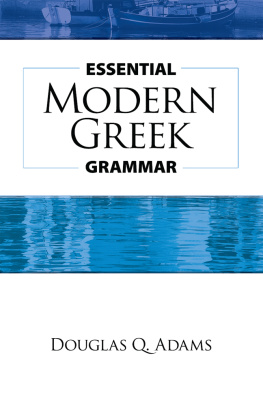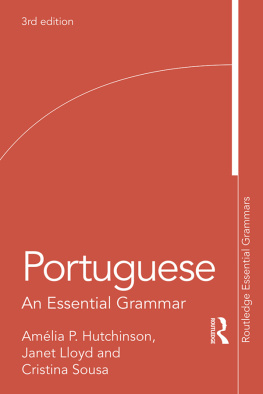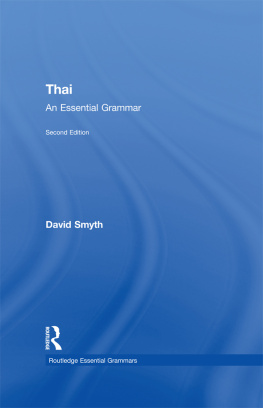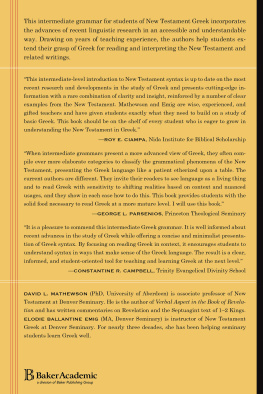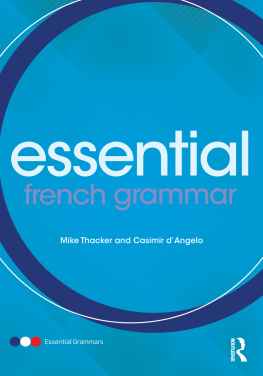First published 2004
This edition published 2016
by Routledge
2 Park Square, Milton Park, Abingdon, Oxon OX14 4RN
and by Routledge
711 Third Ave, New York, NY 10017
Routledge is an imprint of the Taylor & Francis Group, an informa business
2016 David Holton, Peter Mackridge and Irene Philippaki-Warburton
The right of David Holton, Peter Mackridge and Irene Philippaki-Warburton to be identified as authors of this work has been asserted by them in accordance with sections 77 and 78 of the Copyright, Designs and Patents Act 1988.
All rights reserved. No part of this book may be reprinted or reproduced or utilised in any form or by any electronic, mechanical, or other means, now known or hereafter invented, including photocopying and recording, or in any information storage or retrieval system, without permission in writing from the publishers.
Trademark notice: Product or corporate names may be trademarks or registered trademarks, and are used only for identification and explanation without intent to infringe.
British Library Cataloguing-in-Publication Data
A catalogue record for this book is available from the British Library
Library of Congress Cataloging-in-Publication Data
A catalog record for this book has been requested
ISBN: 978-1-138-93067-4 (hbk)
ISBN: 978-1-138-93068-1 (pbk)
ISBN: 978-1-315-68030-9 (ebk)
Typeset in Sabon and Gill
by Florence Production Ltd, Stoodleigh, Devon

The aim of this book is to provide a concise, but sufficiently detailed, description of the Greek language as spoken and written in Greece today. Greek is a highly inflected language, and consequently we have had to devote considerable space to the basic patterns of declension and conjugation which learners need to master. However, we also give close attention to the structure of phrases and sentences, i.e. to the syntax of the language, which other grammars have tended to treat rather cursorily. Throughout the book, our intention is to provide a reliable guide to Greek grammar and usage, up to date in terms of both its linguistic approach and the linguistic material we use to exemplify the various aspects of the language.
The book is intended to serve the needs of adult learners, both those attending classes and those studying alone, of school students up to A level, and of first-year university students, particularly beginners or near-beginners. The terminology used is to a great extent traditional, although we have made certain innovations in the interests of greater transparency and precision (as we did in the Comprehensive Grammar which we co-authored). For example, we talk about the simple past tense rather than the aorist, a term inherited from descriptions of Ancient Greek grammar, but no longer meaningful for the modern language. All linguistic terms are fully explained in the text, as well as in the glossary. We frequently contrast Greek with English, in order to aid the learner in understanding the linguistic concepts and categories involved. Attention is paid to particular points of difficulty for English-speaking learners and to the most important differences between the two languages. All the linguistic features we discuss are illustrated by appropriate examples of their use in whole phrases or sentences. We give priority to the everyday spoken language, and this is reflected in the idiomatic language of the English translations given for all examples. More formal spoken and written usages, whether of grammatical forms or of sentence structures, are also noted and signalled as such.
This grammar is intended to serve as a work of reference. It does not provide a graded course of study, for which we assume the learner will use other materials. (Some suggestions of suitable works are given at the end of the book.) What the book does offer, in comparison with most methods, is more detailed and systematically organized information about the linguistic features which the learner will encounter. Users can consult the grammar in order to supplement the basic information presented in course books, and thus acquire a fuller understanding of the grammatical structure of Greek and patterns of contemporary usage.
Some comparison should be made with our Greek: A Comprehensive Grammar of the Modern Language . The present volume is not simply a shortened version of the earlier one, omitting the less common features of the language. While it is true that we have omitted a good many morpho-logical features that are not commonly used in the spoken language, the Essential Grammar is structured in a quite different way: grammatical forms and their usage are generally covered together (rather than being separated in different parts of the book). As far as possible we have avoided repetition of the same material, such as examples of usage. The presentation of grammatical phenomena in the present work takes into account the different needs of its users, and, as already mentioned, there is more explicit comparison with English. On the other hand, the two books have much in common as regards the analysis presented and the terminology used. Users of this book who wish to continue their study of Greek to a more advanced level will be able to progress to the Comprehensive Grammar , where they will find further and more detailed information about forms and structures which native speakers employ in spoken and written registers.
Finally, a note on pronunciation: in the sections that deal with the sounds of Greek and with stress patterns, the underlying sounds are given between slashes (/ /). These sounds may have different variants in pronunciation. The actual pronunciation is given in square brackets ([]), using a simplified version of the International Phonetic Alphabet (IPA). Learners who are not familiar with the IPA are advised to study the sections describing the pronunciation of individual vowels and consonants, and either to consult a native speaker or to listen to suitable cassettes, in order to acquire a sure grasp of the pronunciation of Greek, particularly of those sounds which are not found in English.
David Holton
Peter Mackridge
Irene Philippaki-Warburton
April 2003
Here we list a number of important Greek words that are thoroughly treated or frequently mentioned in the Grammar .
()
(particle)
(preposition)
(conjunction)
()
()
()
(deictic particle)
(subjunctive particle)
()
(complementizer)
, (pronoun and determiner)
()
()
(relative and complementizer)
(question word)
(complementizer)
(question word)
/
()
Routledge Essential Grammars
Essential Grammars are available for the following languages:
Arabic
Chinese
Czech
Danish
Dutch
English
Finnish
Modern Hebrew
German
Greek
Hindi
Hungarian
Korean
Latvian
Norwegian
Polish
Portuguese
Romanian
Serbian
Spanish
Swedish
Thai
Turkish
Urdu
Other titles of related interest published by Routledge:
Greek: A Comprehensive Grammar, 2nd edition
By David Holton, Peter Mackridge and Irene Philippaki-Warburton
Revised by Vassilios Spyropoulos
Colloquial Greek
By Niki Watts
Contents
Note: This glossary should be used in conjunction with the Index of grammatical categories and concepts, which refers to the specific pages of the Grammar where these terms are discussed. Words in italics are terms that are defined in the glossary.

